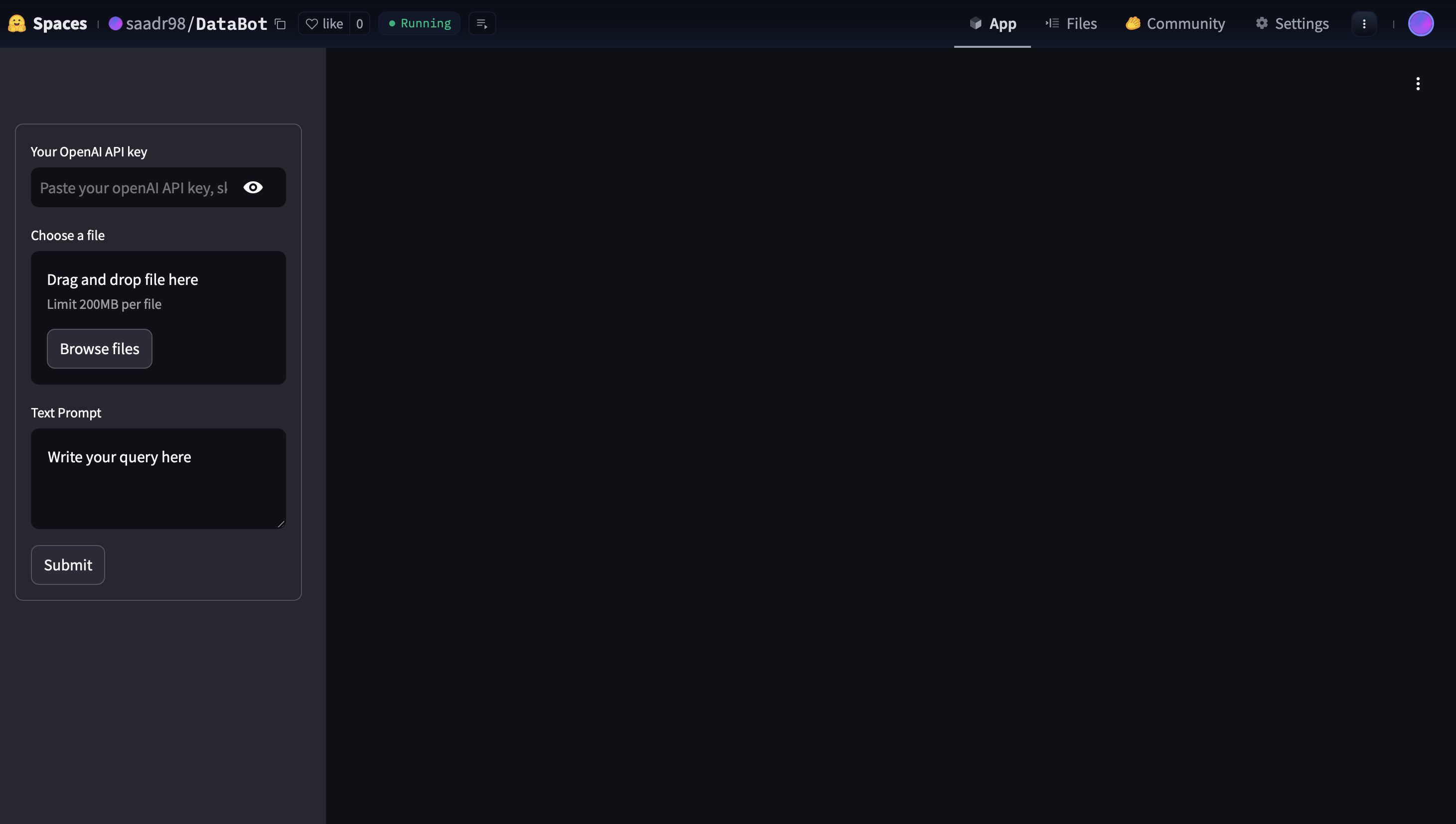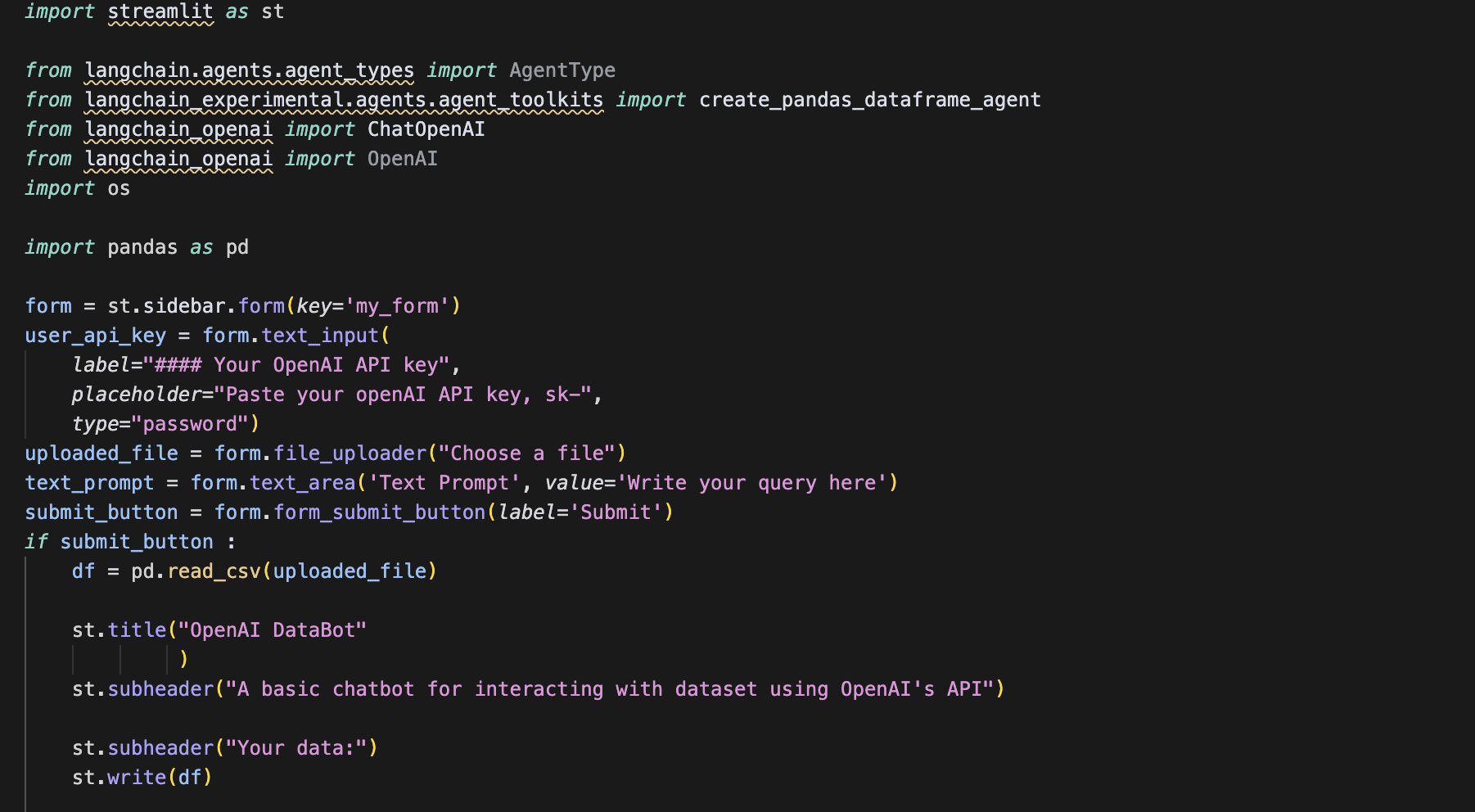Project information
- Category: Data Analysis, AI, Natural Language Processing, LLM Applications
- Project date: June, 2024
- GitHub: OpenAI DataBot
- Demo: HuggingFace Space
Introduction
OpenAI DataBot is an interactive web application that leverages the power of OpenAI's language models to analyze and interpret datasets through natural language. This tool bridges the gap between complex data analysis and human understanding by allowing users to interact with their data using simple, conversational language.
The application provides a user-friendly interface built with Streamlit, where users can upload their CSV datasets, input natural language queries about their data, and receive comprehensive, AI-generated responses. By combining the analytical capabilities of pandas with the natural language understanding of OpenAI's models, DataBot makes data exploration accessible to users regardless of their technical expertise in data analysis or programming.
Objective
The primary objectives of this project were to:
- Create an intuitive interface for data analysis that requires no coding knowledge from end users
- Leverage OpenAI's language models to interpret and execute natural language queries on datasets
- Build a system capable of generating insightful analyses and visualizations based on user questions
- Implement a secure method for users to use their own OpenAI API keys with the application
- Develop a responsive web application that can handle various dataset formats and sizes
- Demonstrate the practical application of LangChain framework for creating AI-powered data analysis tools
- Bridge the gap between complex data analysis techniques and non-technical users
- Showcase how large language models can be used as reasoning engines for interpreting data
Process
The development of the OpenAI DataBot involved several key phases:
- Requirement Analysis: Identified the need for a tool that enables non-technical users to analyze data through natural language
- Framework Selection: Chose Streamlit for its simplicity in building data applications and LangChain for its agent capabilities
- User Interface Design: Created a clean, intuitive sidebar form for user inputs including API key entry, file upload, and query input
- Backend Integration: Implemented the LangChain pandas DataFrame agent with OpenAI's ChatGPT model as the reasoning engine
- Data Processing: Set up pandas DataFrame handling for CSV file uploads with appropriate error handling
- OpenAI API Integration: Configured secure API key handling to protect user credentials while enabling model access
- Agent Configuration: Fine-tuned the pandas DataFrame agent to interpret queries correctly and generate relevant Python code
- Response Formatting: Implemented clean presentation of both the raw data and the AI-generated analysis
- Error Handling: Added robust error handling for API issues, malformed queries, and data processing problems
- Testing: Conducted extensive testing with various datasets and query types to ensure accuracy and responsiveness
- Application Deployment: Prepared the application for easy deployment on both local and cloud-based environments
Tools and Technologies
This project leveraged a comprehensive set of tools and technologies:
Platforms:
- Streamlit (web application framework)
- OpenAI API (language model access)
- GitHub (version control and project hosting)
Programming Language:
- Python 3.x
Libraries:
- Streamlit
- LangChain
- LangChain Experimental (agent toolkits)
- pandas
- OpenAI Python SDK
Techniques and Components:
- LLM (Large Language Model) Integration
- Agent-based Architecture
- Natural Language Processing
- Data Frame Analysis
- Web-based User Interface
- API Key Management
- File Upload and Processing
- Dynamic Query Handling
Democratizing Data Analysis Through AI
OpenAI DataBot represents a significant step toward democratizing data analysis by making it accessible through natural language. Traditional data analysis requires specialized knowledge of programming languages like Python and libraries like pandas, creating a high barrier to entry for non-technical users who need to extract insights from their data.
The application demonstrates how large language models can serve as the interface between human intent and technical execution. Users can simply ask questions like "What's the correlation between column A and column B?" or "Show me a summary of the top 5 values in this dataset" without needing to know the underlying pandas commands or syntax.
By leveraging LangChain's agent framework, DataBot doesn't just return predefined analyses but actively reasons about the user's intent and generates appropriate code to answer their specific questions. This creates a powerful, flexible tool that can adapt to various datasets and query types without requiring reprogramming.
The value of DataBot extends beyond simple convenience—it enables organizations to extract more value from their data by allowing all team members, regardless of technical background, to perform sophisticated analyses. This democratization of data analysis has the potential to drive better decision-making across all levels of an organization.


